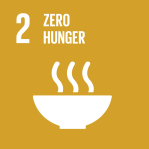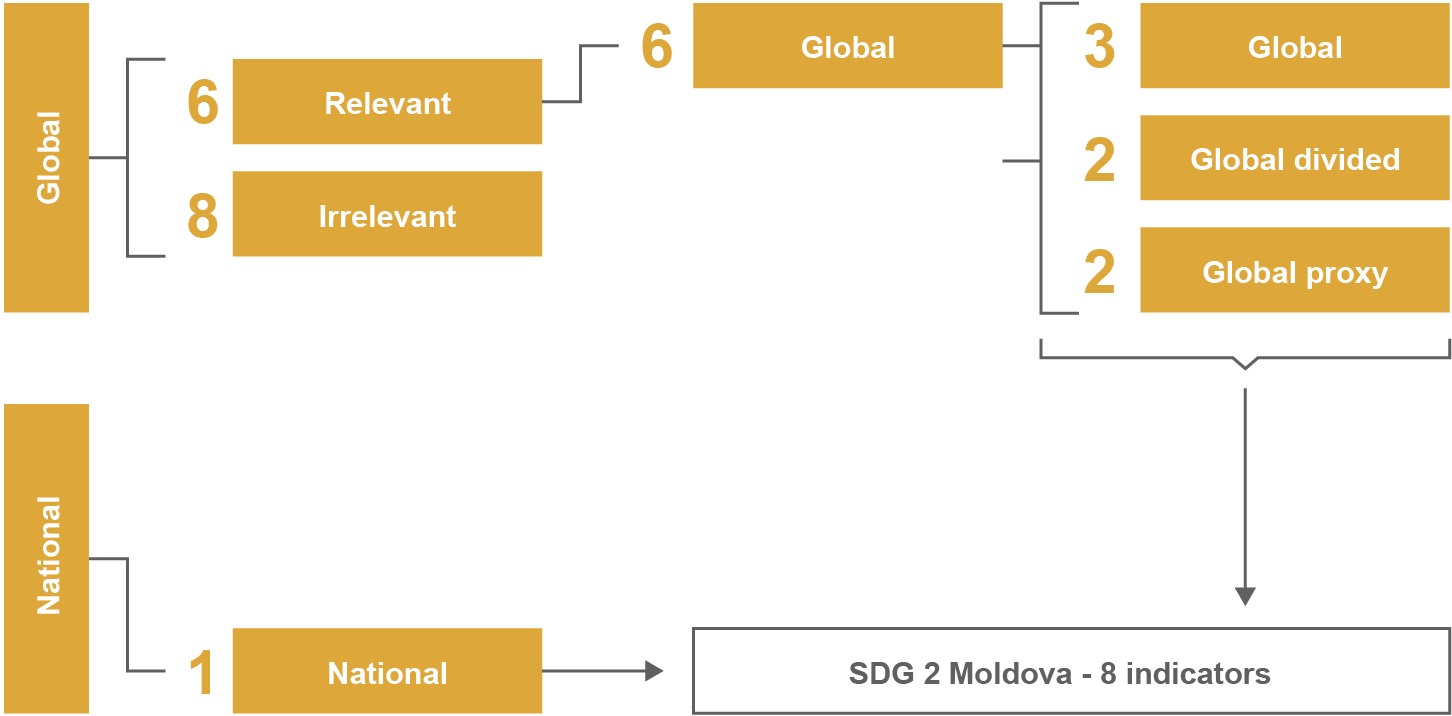The 2030 Agenda under Goal 2 puts an emphasis on ending all forms of malnutrition and addressing the nutritional needs of the groups of population affected or at risk, such as children, pregnant and lactating women and the elderly. Moreover, more productive and climate-resilient agricultural practices will be promoted in the country. The agents of this change will include small-scale food producers and agriculture businesses, which should see increased incomes and more secure access to productive resources, inputs, knowledge, financial services and markets. These should help maintain ecosystems and strengthen capacity for adaptation to climate change, extreme weather conditions, such as drought, flooding and other disasters, and protection of human health.
|
| Results of indicators nationalization SDG 2
|
| Goal 2. End hunger, achieve food security and improved nutrition and promote sustainable agriculture |
|
| Goal 2. End hunger, achieve food security and improved nutrition and promote sustainable agriculture | |
| GLOBAL TARGETS 2019 | GLOBAL INDICATORS 2019 |
| NATIONAL TARGETS 2017* | NATIONAL INDICATORS 2017* |
| 2.1 By 2030, end hunger and ensure access by all people, in particular the poor and people in vulnerable situations, including infants, to safe, nutritious and sufficient food all year round | 2.1.1 Prevalence of undernourishment |
| Not relevant | |
|
| 2.1.2 Prevalence of moderate or severe food insecurity in the population, based on the Food Insecurity Experience Scale (FIES) |
| | |
| 2.2 By 2030, end all forms of malnutrition, including achieving, by 2025, the internationally agreed targets on stunting and wasting in children under 5 years of age, and address the nutritional needs of adolescent girls, pregnant and lactating women and older persons | 2.2.1 Prevalence of stunting (height for age <-2 standard deviation from the median of the World Health Organization (WHO) Child Growth Standards) among children under 5 years of age |
| 2.2 By 2030, end all forms of malnutrition and address the nutritional needs of adolescent girls, pregnant and lactating women and older persons | 2.2.1 Prevalence of undernourishment |
|
| 2.2.2 Prevalence of malnutrition (weight for height >+2 or <-2 standard deviation from the median of the WHO Child Growth Standards) among children under 5 years of age, by type (wasting and overweight) |
| | 2.2.2 Prevalence of malnutrition |
| 2.3 By 2030, double the agricultural productivity and incomes of small-scale food producers, in particular women, indigenous peoples, family farmers, pastoralists and fishers, including through secure and equal access to land, other productive resources and inputs, knowledge, financial services, markets and opportunities for value addition and non-farm employment | 2.3.1 Volume of production per labour unit by classes of farming/pastoral/forestry enterprise size |
| 2.3 Increase agricultural productivity and incomes of small-scale food producers through secure and equal access to productive resources, inputs, knowledge, financial services and markets. | 2.3.1.1 Proportion of used agricultural land in the total agricultural land |
|
|
|
| | 2.3.1.2 Labour productivity in agriculture |
|
| 2.3.2 Average income of small-scale food producers, by sex and indigenous status |
| | 2.3.2 Proportion of small agricultural producers production volume in total agricultural production |
| 2.4 By 2030, ensure sustainable food production systems and implement resilient agricultural practices that increase productivity and production, that help maintain ecosystems, that strengthen capacity for adaptation to climate change, extreme weather, drought, flooding and other disasters and that progressively improve land and soil quality | 2.4.1 Proportion of agricultural area under productive and sustainable agriculture |
| 2.4 By 2030, implement resilient agricultural practices that increase productivity, help maintain ecosystems and strengthen capacity for adaptation to climate change, extreme weather as drought, flooding and other disasters | 2.4.1.1 Percentage of agricultural land using sustainable agricultural practices |
|
|
|
| | 2.4.1.2 Share of agricultural land with intensive agriculture in total agricultural land |
| 2.5 By 2020, maintain the genetic diversity of seeds, cultivated plants and farmed and domesticated animals and their related wild species, including through soundly managed and diversified seed and plant banks at the national, regional and international levels, and promote access to and fair and equitable sharing of benefits arising from the utilization of genetic resources and associated traditional knowledge, as internationally agreed | 2.5.1 Number of plant and animal genetic resources for food and agriculture secured in either medium- or long-term conservation facilities |
| Not relevant | |
|
| 2.5.2 Proportion of local breeds classified as being at risk, not at risk or at unknown level of risk of extinction |
| | |
| 2.a Increase investment, including through enhanced international cooperation, in rural infrastructure, agricultural research and extension services, technology development and plant and livestock gene banks in order to enhance agricultural productive capacity in developing countries, in particular least developed countries | 2.a.1 The agriculture orientation index for government expenditures |
| Not examined | |
|
| 2.a.2 Total official flows (official development assistance plus other official flows) to the agriculture sector |
| | |
| 2.b Correct and prevent trade restrictions and distortions in world agricultural markets, including through the parallel elimination of all forms of agricultural export subsidies and all export measures with equivalent effect, in accordance with the mandate of the Doha Development Round | 2.b.1 Agricultural export subsidies |
| Not examined | 2.b.2 Subsidies for agri-food exports |
| 2.c Adopt measures to ensure the proper functioning of food commodity markets and their derivatives and facilitate timely access to market information, including on food reserves, in order to help limit extreme food price volatility | 2.c.1 Indicator of food price anomalies |
| 2.c Adopt measures to ensure the proper functioning of food commodity markets and their derivatives and facilitate timely access to market information, including on food reserves, in order to help limit extreme food price volatility | |
Note:
* Nationalized targets, nationalized indicators and statistical data presented under this heading are taken from the Report "Nationalization of indicators for SDG" and Adapting the 2030 Agenda on Sustainable Development to the context of the Republic of Moldova elaborated by Expert-Grup in collaboration with the Government of the Republic of Moldova and UN Moldova in 2017 and presents the situation at that time. Currently, the next stage of revising the nationalized indicators is taking place, thus, some indicators can be revised or supplemented later.
 |  |  |  |  |  |  |  |  |
 |  |  |  |  |  |  |  |  |


 Goal 2: End hunger, achieve food security and improved nutrition and promote sustainable agriculture
Goal 2: End hunger, achieve food security and improved nutrition and promote sustainable agriculture 
 Green line: 022 40 30 00
Green line: 022 40 30 00